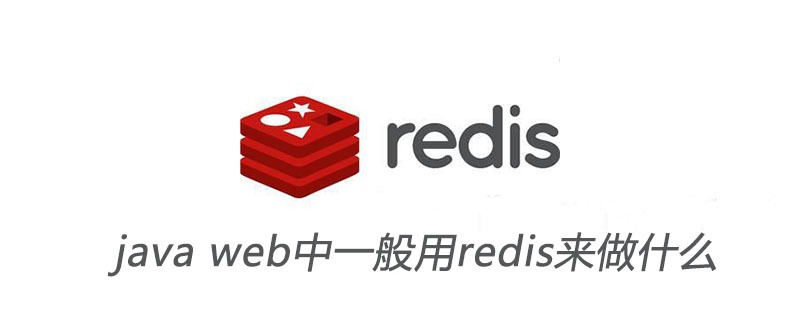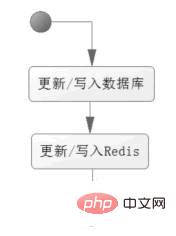What is redis generally used for in java web?
Generally speaking, there are two main scenarios for Redis in Java Web applications. One is to cache commonly used data, and the other is to use it to read/write quickly when high-speed reading/writing is required. For example, there are occasions when it is necessary to rush to buy goods and grab red envelopes.

Due to high-speed reading/writing of data in high-concurrency situations, one of the core issues is data consistency and access control.
# (Recommended learning: Redis Video Tutorial )
## In the reading/writing operation of the database, the real situation is The number of read operations far exceeds the number of write operations, generally at a ratio of 1:9 to 3:7, so the possibility of reading is much greater than the possibility of writing. When sending SQL to the database for reading, the database will go to the disk to index the corresponding data back, and indexing the disk is a relatively slow process. If the data is placed directly on the Redis server running in the memory, then there is no need to read/write the disk, but directly read the memory, which will obviously be much faster and will greatly reduce the pressure on the database. The use of memory to store data is also relatively expensive, because the disk can be TGB level, and it is very cheap. The memory is generally a few hundred GB, which is quite remarkable. Therefore, although the memory is efficient, the space is limited and the price It is also much higher than the disk, so the cost of using memory is high. It is not possible to store whatever you want, so we should consider conditional storage of data. Generally speaking, some commonly used data is stored, such as user login information; some major business information, such as banks will store some basic customer information, bank card information, recent transaction information, etc. Generally speaking, when using Redis storage, you need to consider three aspects. Is business data commonly used? What's the hit rate? If the hit rate is low, there is no need to write to the cache. Whether the business data has a lot of read operations or a lot of write operations? If there are a lot of write operations, it needs to be written to the database frequently, and there is no need to use cache. What is the size of business data? If you want to store hundreds of megabytes of files, it will put a lot of pressure on the cache. Is it necessary? After considering these issues, if you feel it is necessary to use caching, then use it. The read logic for using Redis as cache is shown in Figure 1.

High-speed reading/writing occasions
In Internet applications, there are often some occasions that require high-speed reading/writing, such as flash sales of products, grabbing red envelopes, Taobao, JD.com’s Double Eleven event or Spring Festival ticket grabs, etc. In the above situations, thousands of requests will reach the server in an instant. If a database is used, the database needs to execute thousands of SQLs in an instant, which can easily cause a bottleneck in the database. In severe cases, it will cause database paralysis and cause the Java Web system service to crash. The response to such situations is often to consider asynchronous writing to the database, and in high-speed reading/writing situations, use Redis alone to cache the data that requires high-speed reading/writing into Redis. , and when certain conditions are met, these cached data are triggered to be written into the database. Let’s first look at the flow chart of a request operation, as shown in Figure 3.
The above is the detailed content of What is redis generally used for in java web?. For more information, please follow other related articles on the PHP Chinese website!

Hot AI Tools

Undresser.AI Undress
AI-powered app for creating realistic nude photos

AI Clothes Remover
Online AI tool for removing clothes from photos.

Undress AI Tool
Undress images for free

Clothoff.io
AI clothes remover

Video Face Swap
Swap faces in any video effortlessly with our completely free AI face swap tool!

Hot Article

Hot Tools

Notepad++7.3.1
Easy-to-use and free code editor

SublimeText3 Chinese version
Chinese version, very easy to use

Zend Studio 13.0.1
Powerful PHP integrated development environment

Dreamweaver CS6
Visual web development tools

SublimeText3 Mac version
God-level code editing software (SublimeText3)

Hot Topics
 1386
1386
 52
52
 How to build the redis cluster mode
Apr 10, 2025 pm 10:15 PM
How to build the redis cluster mode
Apr 10, 2025 pm 10:15 PM
Redis cluster mode deploys Redis instances to multiple servers through sharding, improving scalability and availability. The construction steps are as follows: Create odd Redis instances with different ports; Create 3 sentinel instances, monitor Redis instances and failover; configure sentinel configuration files, add monitoring Redis instance information and failover settings; configure Redis instance configuration files, enable cluster mode and specify the cluster information file path; create nodes.conf file, containing information of each Redis instance; start the cluster, execute the create command to create a cluster and specify the number of replicas; log in to the cluster to execute the CLUSTER INFO command to verify the cluster status; make
 How to clear redis data
Apr 10, 2025 pm 10:06 PM
How to clear redis data
Apr 10, 2025 pm 10:06 PM
How to clear Redis data: Use the FLUSHALL command to clear all key values. Use the FLUSHDB command to clear the key value of the currently selected database. Use SELECT to switch databases, and then use FLUSHDB to clear multiple databases. Use the DEL command to delete a specific key. Use the redis-cli tool to clear the data.
 How to read redis queue
Apr 10, 2025 pm 10:12 PM
How to read redis queue
Apr 10, 2025 pm 10:12 PM
To read a queue from Redis, you need to get the queue name, read the elements using the LPOP command, and process the empty queue. The specific steps are as follows: Get the queue name: name it with the prefix of "queue:" such as "queue:my-queue". Use the LPOP command: Eject the element from the head of the queue and return its value, such as LPOP queue:my-queue. Processing empty queues: If the queue is empty, LPOP returns nil, and you can check whether the queue exists before reading the element.
 How to use the redis command
Apr 10, 2025 pm 08:45 PM
How to use the redis command
Apr 10, 2025 pm 08:45 PM
Using the Redis directive requires the following steps: Open the Redis client. Enter the command (verb key value). Provides the required parameters (varies from instruction to instruction). Press Enter to execute the command. Redis returns a response indicating the result of the operation (usually OK or -ERR).
 How to use redis lock
Apr 10, 2025 pm 08:39 PM
How to use redis lock
Apr 10, 2025 pm 08:39 PM
Using Redis to lock operations requires obtaining the lock through the SETNX command, and then using the EXPIRE command to set the expiration time. The specific steps are: (1) Use the SETNX command to try to set a key-value pair; (2) Use the EXPIRE command to set the expiration time for the lock; (3) Use the DEL command to delete the lock when the lock is no longer needed.
 How to read the source code of redis
Apr 10, 2025 pm 08:27 PM
How to read the source code of redis
Apr 10, 2025 pm 08:27 PM
The best way to understand Redis source code is to go step by step: get familiar with the basics of Redis. Select a specific module or function as the starting point. Start with the entry point of the module or function and view the code line by line. View the code through the function call chain. Be familiar with the underlying data structures used by Redis. Identify the algorithm used by Redis.
 How to make message middleware for redis
Apr 10, 2025 pm 07:51 PM
How to make message middleware for redis
Apr 10, 2025 pm 07:51 PM
Redis, as a message middleware, supports production-consumption models, can persist messages and ensure reliable delivery. Using Redis as the message middleware enables low latency, reliable and scalable messaging.
 How to start the server with redis
Apr 10, 2025 pm 08:12 PM
How to start the server with redis
Apr 10, 2025 pm 08:12 PM
The steps to start a Redis server include: Install Redis according to the operating system. Start the Redis service via redis-server (Linux/macOS) or redis-server.exe (Windows). Use the redis-cli ping (Linux/macOS) or redis-cli.exe ping (Windows) command to check the service status. Use a Redis client, such as redis-cli, Python, or Node.js, to access the server.




